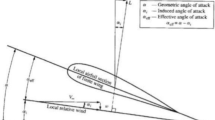Summary
It has been suggested that in the conditions of lifting re-entry caret wings are likely to have higher lift coefficients than flat-bottomed wings with the same ratio of lift to drag. Thus, for given speed and wing loading, they can re-enter at higher altitudes with a consequent reduction in stagnation point heating rate. In this paper thin-shock-layer theory is used to study the lifting properties of caret and flat-bottomed wings and of wings with concave lower surfaces. It is found that significant gains in lift coefficient can be achieved with moderately recessed lower surfaces. These results hold for both perfect and real gas flows.
Übersicht
Man hat vermutet, daß dachartig geknickte Auftriebsflächen beim Wiedereintritt in die Erdatmosphäre einen größeren Auftriebskoeffizienten haben als flache Flügel mit demselben Verhältnis von Auftrieb zu Widerstand. Auf diese Weise können sie bei gegebener Geschwindigkeit und Flügelbelastung bei größeren Höhen wieder eintreten und führen dabei zu einer geringeren Erhitzung im Staupunkt. In der vorliegenden Arbeit wird eine auf der Annahme einer dünnen Stoßschicht basierende Theorie verwendet, um die Auftriebseigenschaften von gefalteten und flachen Deltaflügeln sowie von Flügeln mit konkaver Unterseite zu untersuchen. Es stellt sich heraus, daß eine bedeutende Verbesserung des Auftriebskoeffizienten durch schwach eingeknickte Unterseiten erreicht werden kann. Diese Ergebnisse gelten sowohl für ideale wie auch für reale Gasströmungen.
Similar content being viewed by others
References
Townend, L. H., Some design aspects of space shuttle orbiters, R.A.E. TR 1970.
Messiter, A. F., Lift of slender delta wings according to Newtonian theory, AIAA J. 1 (1963) p. 794.
Hida, K., Thickness effects on the force of slender wings in hypersonic flow, AIAA J. 3 (1965) p. 427.
Squire, L. C., Calculated pressure' distributions and shock shapes on conical wings with attached shock waves, Aero, Quart XIX (1968) p. 31.
Squire, L. C., Calculated pressure distributions and shock shapes on thick conical wings at high supersonic speeds, Aero. Quart. XVIII (1967), p. 185.
Squire, L. C., Calculations of the pressure distributions on lifting conical wings with applications to the off-design behaviour of waveriders, Paper 11 in ARGARD Conf. Proc. 30, 1968.
Hillier, R., The effects of yaw on conical wings at high supersonic speeds, Aero. Quart. XXI (1970) p. 199.
Squire, L. C., Pressure distributions and flow patterns at M = 4.0 on some delta wings, Aero. Res. Council. Rep. and Memo. 3373, 1963.
Peckham, D. H., Pressure distribution measurements on a series of slender body shapes at Mach numbers of 6.85 and 8.60, Aero. Res. Council. CP 791, 1962.
Bertram, M. H., Henderson, A., Recent Hypersonic studies of wings and bodies, ARS J. 3 (1961) p. 1129.
Kipke, K., Experimental investigations of waveriders in the Mach number range from 8 to 15. Paper 13 in AGARD Conf. Proc. 30, 1968.
Keldysh, V. V., The investigation of the flow in the vicinity of V shaped wings formed by stream surfaces behind a plane shock wave, Mikhanika Zhidkosti I Gaza 4 (1967), R.A.E. Library Translation No. 1407, 1969.
Squire, L. C., Experimental results for waveriders in certain off-design conditions, submitted for publication.
Squire, L. C., Roe, P. L., Off-design conditions for waveriders, unpublished.
Bertram, M. H., Cook, B. S., The correlation of oblique shock parameters for ratios of specific heats from 1 to 5/3 with applications to real gas flows, NASA TR-R-171, 1963.
Trimpi, R. L., Jones, R. A., A method of solution with tabulated results for attached oblique shock-wave systems for surfaces at verious angles of attach, sweep, and dihedral in an equilibrium real gas including the atmosphere, NASA TR-R-63, 1960.
Author information
Authors and Affiliations
Rights and permissions
About this article
Cite this article
Squire, L.C. A comparison of the lift of flat delta wings and waveriders at high angles of incidence and high mach number. Ing. arch 40, 339–352 (1971). https://doi.org/10.1007/BF00533150
Received:
Issue Date:
DOI: https://doi.org/10.1007/BF00533150




